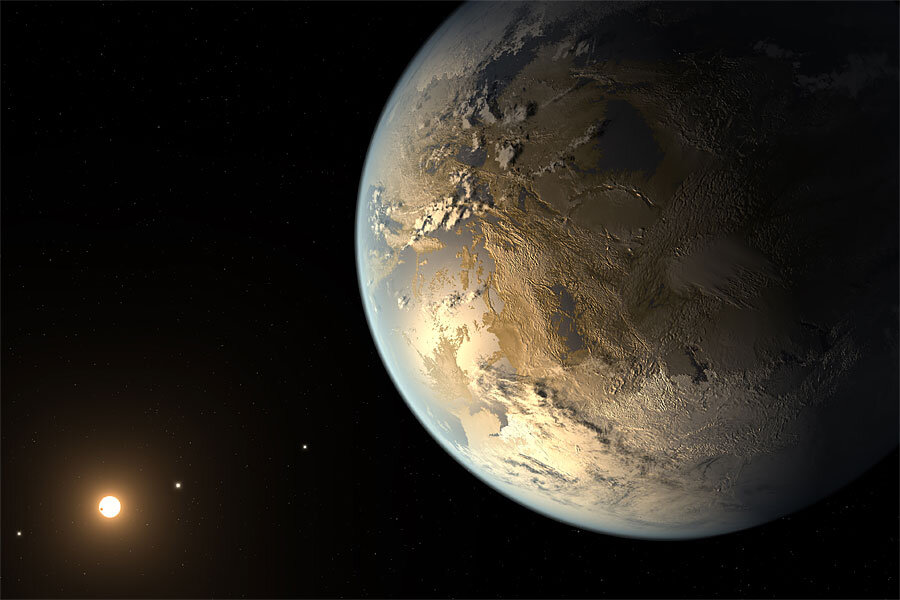Planet hunters spot eight potentially habitable worlds
Loading...
Sen—Scientists are expanding the range of worlds that could orbit in habitable regions of their stars—worlds that are rocky, such as the Earth, and could have just the right temperature to host life.
Of the eight planets discovered in the latest finding discussed today, 6 January, the scientists consider two to be pretty close in range to Earth. They are called Kepler-438b and Kepler-442b, after the space observatory that discovered them.
While these exoplanets are 12 per cent and 33 per cent larger than Earth, respectively, their star is a much smaller red dwarf than our Sun.
"Small habitable-zone planets like the ones we have validated are by far the most interesting kind, for their potential to harbour life as we know it," lead author Guillermo Torres, of the Harvard-Smithsonian Center for Astrophysics, told Sen.
"Precious few planets with these characteristics have been found, despite predictions that they should be rather common. Our paper essentially doubles the known sample of these objects, which supports the predictions."
He added: "Although the ones we validated orbit faint stars and are difficult to study further, confirming that there are many of these out there is important because it means some must orbit brighter stars, which are much easier to study. For example, this may enable astronomers to detect and study the atmospheres of small habitable-zone planets and even search for 'biomarkers', signatures of biological activity."
The planets were found using the Kepler space telescope, a planet hunter that spent roughly four years scouring a small region in the Cygnus constellation for exoplanets.
Kepler is still active now, but periodically moving its eyes to different regions of the sky under a mission called K2. This uses the pressure of the Sun's light to maintain the telescope's position in space, since the telescope lost the use two of four reaction wheels required to keep its pointing in place.
Since the telescope only looks at different regions of the sky now for about two months, it could miss longer-period planets in the habitable zone, Torres said. Also, the precision is expected to be worse by a factor of two or three, which could make it harder to find smaller planets.
The latest finding portrays the planets as being in the "Goldilocks" region of their respective stars. The expression comes from an old folk tale about porridge, with a young girl called Goldilocks testing three bowls and saying one is too hot, one is too cold, and the last is "just right." A Goldilocks planet is thus defined as being "just right" for life because it is not too hot or cold.
Figuring out if a planet is habitable, however, comes down to more than knowing how far it orbits from its host star. Other factors that need to be considered are how thick its atmosphere is, how much light it receives, what its atmosphere is made of and if it is hit frequently with small bodies. That said, with current telescope technology, habitable zones are where astronomers begin their searches for potential life-bearing worlds.
The Habitable Exoplanets Catalog, which is maintained by the University of Puerto Rico at Arecibo's planetary habitability laboratory, currently lists 22 potentially habitable worlds (including both verified planets, and planet candidates). Of these, seven of them are Earth-sized and 15 larger than the Earth.
While we are used to thinking about our own Sun as a life-giving star, it is also possible for habitable regions to exist around red dwarfs. A large percentage of these worlds circle these cooler stars, but closer in.
Getting more information about these worlds will be challenging given their great distance from Earth. Kepler-438b is about 470 light-years away, while Kepler-442b more than doubles that distance at 1,100 light years. The planets were so small and far away, in fact, that it took a computer program to validate that they were there.
Called BLENDER, this program has also been used in the past to verify an exoplanet smaller than Mercury, and two Earth-sized planets that were orbiting a star similar to our own sun. The team further verified the new findings with spectroscopy, imaging with adaptive optics and other methods.
"New candidates will continue to emerge from the Kepler (and K2) observations as the analysis pipeline improves with time, and I expect that a few more interesting candidates will be found that will merit BLENDER studies such as the ones in our paper, to validate them," Torres said. "This will require additional follow-up observations, as for the targets in our paper, including high-resolution imaging and spectroscopy."
Meanwhile, Torres pointed to the next generation of large telescopes that will go into space in the next decade or so, such as Europe's PLATO (Planetary Transits and Oscillations of stars). These new observatories should provide more precise information on the planetary mass, which (along with knowing the size) will provide information on the density of the planet. This will help astronomers figure out if the planet is rocky or gaseous, as well as other internal structure properties.
The findings were announced at a meeting of the American Astronomical Society in Seattle. Strong candidates for habitability before this finding include Kepler-186f (1.1 times Earth's size) and Kepler-62f (1.4 times Earth's size).
Related Links:
NASA Kepler: the search for exoplanets
One billion habitable planets in the Milky Way
Original story from Sen. © 2015 Sen TV Limited. All rights reserved. This material may not be published, broadcast, rewritten or redistributed. For more space news visit Sen.com and follow @sen on Twitter.







